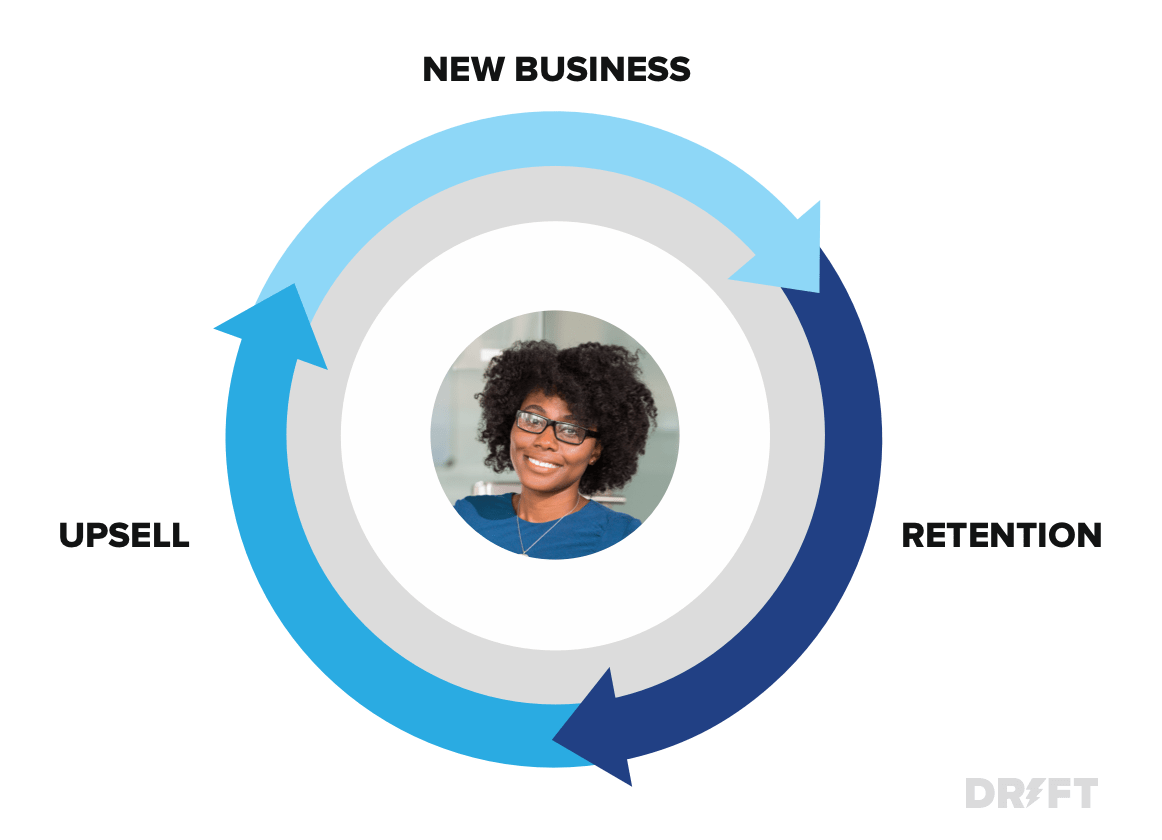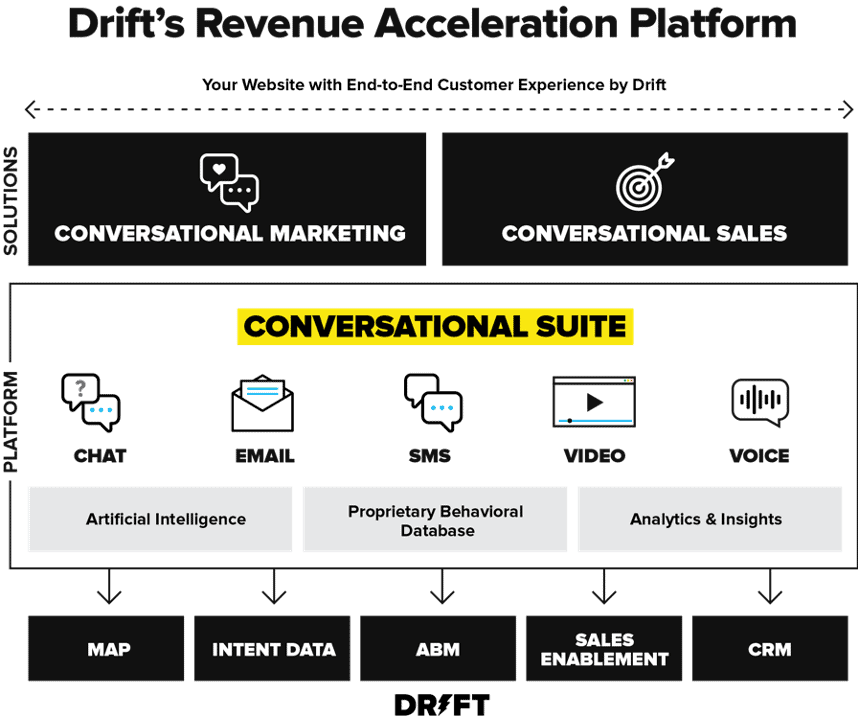Sales has always had a seat at the c-suite table. After all, for CEOs, sales and revenue are top of mind in driving any strategic decision.
But the mindset that revenue growth begins and ends with sales is outdated – primarily because of three key shifts:
- A B2B buyer’s journey that is more nuanced and less predictable than ever
- The rise of SaaS and new subscription-based revenue models that require companies to re-win business and double down on metrics like recurring revenue, churn, up-sell, cross-sell, and net dollar retention
- And rapid innovation that has pushed companies to change growth initiatives and strategies at a moment’s notice
For these reasons, sales’ responsibility around revenue needs to be shared across all revenue-generating teams: marketing, sales, and customer success (CS).
But adapting to this changing landscape has been easier said than done for many B2B businesses. Where some companies have driven full-funnel accountability across revenue teams, others have seen greater division and silos that stunt long-term growth.
Transitioning from a sales leader to a Chief Revenue Officer (CRO) opened my eyes to just how paralyzing a siloed go-to-market approach can be – particularly on sustainable revenue growth.
I’ve always found that to fix a problem, you need to understand it. Here’s why modern marketing, sales, and CS teams are feeling the pain during go-to-market, and what a path forward looks like 👇
Organizational Friction & Why It’s Killing Your GTM Strategy and Bottom Line
As previously mentioned, the B2B economy has changed dramatically due to new technologies and empowered buyers. Some businesses have adapted and thrived under the pressure. Others have reacted a bit like a chicken with its head cut off.
But why?
Companies Struggle to Understand & Connect with Buyers
Despite marketing’s efforts to drive leads and supply sales with a steady pipeline, the problem remains that some companies still have no idea who is on their website right now, how they got there, where they’re from, and why they’re there.
This limited insight has a domino effect on the relationship between marketing and sales, how companies create and forecast pipeline, and so much more.
Now, tell me if you’ve heard any of these before:
- Marketing is measured on leads and doubles down on inbound
Marketing is cranking out content. Sales brings on more SDRs and AEs to manage the inbound workload and follow up on outbound campaigns. - Too little too late for sales
If sales aren’t able to see and respond to buyers on their site in real-time, a clear drop-off happens. Our 2020 State of Conversational Marketing report found that 45% of buyers expect companies to respond to chat within 5 seconds or less. - Sales wastes time on low-quality leads
SDRs and AEs spend their days working leads with low buying intent. When they are able to connect with high-intent buyers, a lack of insight or ability to connect with these buyers in real-time leads to generic follow-ups, longer sales cycles, and frustrated buyers.n - Low conversion rates and slashed budgets
Poor conversion rates on marketing activities create in-fighting between marketing and sales, the shrinking of marketing budgets, and instability on sales teams. Marketing must then continue “seemingly” cost-effective inbound tactics that give the appearance of results (high lead volume), but, in reality, do little to move the needle forward. - Unpredictable pipeline
The final nail in the coffin: unpredictability. An inability to forecast and budget for pipeline – as well as onboarding customers who may not fit your ideal customer profile (ICP) – creates a “leaky funnel effect”: For every new sale that comes in, 10 more customers slip through the cracks and churn.
Today’s buyers have more options and are more empowered than ever before. 70% of the buyer’s journey now happens before a buyer even reaches out to sales. Convoluted journeys filled with forms, long wait times, company in-fighting, and generic follow up creates greater detraction in your funnel.

But acquisition revenue isn’t the only revenue to suffer in a poor go-to-market motion. Expansion and retention revenue are also at risk…
Churn Is Left Unchecked & Expansion Opportunities Are Overlooked
Customer success is a byproduct of the growing SaaS industry. CS has emerged as a key function for driving retention revenue and creating customer relationships that last. Especially with the rise of subscription-based models that force companies to resell to customers over time.
Doubling down on customer relationships is vital for a number of reasons:
- Most B2B sales start with a referral
Nearly 84% of B2B buyers start their buying process with a referral. That means building a good relationship with an account isn’t just about retention – it’s also key to your acquisition strategy. - Churn left unchecked is a slippery slope
Businesses struggling with churn will try to save their sinking ship by focusing on new business. But this is a temporary fix. If you want to create a sustainable business, you need to control and monitor churn with the same rigor as acquisition. - Expansion revenue is key to long-term sustainable growth
Expansion revenue is just as important to your business’ operating model as new business revenue. As your customer’s business needs grow, you’ll want to work with them as a partner to foster new opportunities.
In most organizations, marketing owns the customer experience. Yet, most marketing teams are detached from frontline CS issues and conversations. And because marketers fail to see the bottom-line impact of CS, they may be resistant to investing in customer-focused campaigns that drive growth within accounts.
There’s also a similar struggle happening between sales and CS. CSMs are not natural sellers. Yet many organizations push CSMs to handle expansion opportunities alongside relationship management. In that case, CS must lean on sales to resell into a company, taking them away from focusing on new opportunities.
Luckily, the account manager role has helped bridge the gap between sales and CS for many companies. Account managers also build a relationship within an account, but are more focused on renewals and expansions. This allows CSMs to focus on nurturing relationships and frontline sales to focus on new business.
Disparate Systems & Insights Lead to In-Fighting and Misdirection
Modern marketing, sales, and CS teams are spoiled by data and technology.
Here’s the dirty little secret though: Most of that data isn’t actionable and much of it is siloed in disparate systems behind lock and key. As we’ve already seen, disparate systems often lead to in-fighting and misdirection among revenue teams. Because there is no single source of truth among these teams, they work in silos – guided by different missions, messages, goals, and go-to-market motions.
These businesses suffer because there’s no real full-funnel accountability. Teams aren’t measuring the right things or acting on the right insights.
But how do you get started driving full-funnel accountability? What can business leaders do to break down this vicious cycle and align and action marketing, sales, and CS?
Let’s dive in 👇
Get a Shepherd For Your Revenue: The Rise of the Chief Revenue Officer
For all the reasons I mentioned earlier, the need for revenue oversight is high in B2B businesses – especially in the SaaS space.
This has led to the creation of roles like my own: The CRO.
The CRO earned a seat at the c-suite table because revenue growth needs oversight. It needs constant maintenance and tweaking. And it needs someone at the helm removing silos and identifying the strategic levers to pull that will grow a company’s revenue.
In my work, I focus on growing all revenue functions. For this reason, I touch marketing, sales, and CS – and collaborate deeply with each team’s leader.
To be clear, the CRO is not here to replace the Chief Marketing Officer (CMO), or the Chief Financial Officer (CFO), or any other c-suite related acronym that comes to mind.
Where the CMO has a broader charter of responsibilities like brand, product marketing, demand generation, PR, and more, the CRO is focused on all things revenue: new logo acquisition, existing account expansion, account management, renewals, enablement, etc. Having someone with this oversight is necessary for identifying opportunities and breaking down organizational silos that create roadblocks to growth.
But having a shepherd overseeing your revenue is just a first step. It’s on CROs like myself to work with marketing, sales, and CS leaders to align and action revenue teams for go-to-market.
Action & Align Your Revenue Teams
For years businesses have been talking about digital transformation and the need to streamline the customer experience – but not the internal changes that need to happen in parallel.
As companies get smarter about their growth, they must introduce new processes to align and action their go-to-market teams.
One of the best ways to get these teams on the same page? Rallying them around the customer. Customer lifetime value (CLV) is a key metric used to tie marketing, sales, and CS to both the customer and revenue. These teams each own a revenue segment that impacts the experience and success of CLV.

Unifying your core metrics in this way is necessary to solve the disconnect between marketing, sales, and CS. Once teams have a single source of truth around metrics and data, instead of debating who’s got the right number or why the data doesn’t match up, companies can:
- Identify deal risk and upsides
- Accelerate current quarter pipeline
- And accurately predict revenue and forecast future quarters
But alignment isn’t enough. Yes, having a shared view can get teams on the same page – but it can’t solve some of the other problems we already mentioned. Problems like connecting with customers in real-time and solving website conversion issues. Or arming sales with the information they need to prioritize accounts and personalize outreach.
In these cases, you need more than alignment. You need a way to action marketing, sales, and CS.
That’s where Revenue Acceleration comes into play. Revenue Acceleration provides the tactics and solutions for marketing, sales, and CS to connect with buyers and customers and take action in their daily work.
Drift customers use our Revenue Acceleration Platform to drive pipeline and action teams to engage, convert, and grow current and future customer relationships.

It’s the same reason we’ve found our own success here at Drift. As a hypergrowth company, it’s essential for us to connect with our customers in real-time. But that outreach needs to be informed, authentic, and personalized to their journey. Revenue Acceleration creates connections with buyers in real-time and delivers personalized customer experiences. This increases your revenue, shortens your sales cycles, and strengthens your brand.
Once you have a process and solution in place to bring these teams together, the final step is operationalizing the change. We like to call this “building an engine” at Drift, but really you’re building your own go-to-market playbook.
Create Your GTM Playbook
We’re in unprecedented times – 2020 has forced us to throw out well-laid plans and required companies to address flaws in their go-to-market strategy and customer experience at lightning speed.
Analysts now say that six years of digital transformation is happening in one. In addition, companies looking to remove silos across their teams are dealing with a more distributed workforce and customer base.
If there was ever a moment for your company – and revenue teams – to come together, it’s now.
That’s why I’m sharing Drift’s The Go-To-Market Guide to Drift — the ultimate playbook for getting your revenue teams aligned and enabled on how to use Drift.
I hope you find it invaluable as you work to create your own go-to-market strategy, align your GTM teams, and drive hypergrowth for your business.







